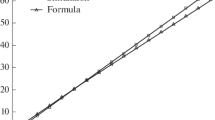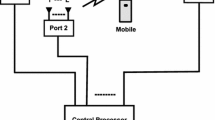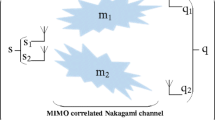Abstract
A model of a MIMO fading channel is considered which does not assume that the discrete-time axis is divided into long intervals with a constant channel. It assumes only that there are ℓ possible states (or subchannels) of the channels, and at each moment both the transmitter and receiver know the channel state. The average input power in the subchannels can be different and not equal to the average input power over the full time axis. We obtain a lower bound for the capacity of the considered vector channel. Also, we consider a vector channel with one transmitting and two or more receiving antennas. We obtain optimum distributions of the average power over the subchannels and lower bounds for the channel capacity.
Similar content being viewed by others
References
Goldsmith, A., Jafar, S.A., Jindal, N., and Vishwanath, S., Capacity Limits of MIMO Channels, IEEE J. Select. Areas Commun., 2003, vol. 21, no. 5, pp. 684–702.
Garg, V.K., IS-95 CDMA and CDMA2000: Cellular/PCS Systems Implementation, Upper Saddle River, NJ: Prentice Hall, 2000.
Goldsmith, A.J. and Varaiya, P.P., Capacity of Fading Channels with Channel Side Information, IEEE Trans. Inform. Theory, 1997, vol. 43, no. 6, pp. 1986–1992.
Ovseevich, I.A., Capacity of a Randomized Channel with Feedback and Matching of the Source, Probl. Peredachi Inf., 1968, vol. 4,no. 1, pp. 52–59 [Probl. Inf. Trans. (Engl. Transl.), 1968, vol. 4, no. 1, pp. 41–46].
Tse, D. and Viswanath, P., Fundamentals of Wireless Communication, Cambridge: Cambridge Univ. Press, 2005. Available at http://www.eecs.berkeley.edu/~dtse/main.pdf.
Csiszár, I. and Narayan, P., Capacity of the Gaussian Arbitrarily Varying Channel, IEEE Trans. Inform. Theory, 1991, vol. 37,no. 1, pp. 18–26.
Wolfowitz, J., Coding Theorems of Information Theory, Berlin: Springer, 1961. Translated under the title Teoremy kodirovaniya teorii informatsii, Moscow: Mir, 1967.
Shin, H. and Lee, J.H., Capacity of Multiple-Antenna Fading Channels: Spatial Fading Correlation, Double Scattering, and Keyhole, IEEE Trans. Inform. Theory, 2003, vol. 49, no. 10, pp. 2636–2647.
Biglieri, E., Proakis, J., and Shamai (Shitz), S., Fading Channels: Information-Theoretic and Communications Aspects, IEEE Trans. Inform. Theory, 1998, vol. 44, no. 6, pp. 2619–2692.
Médard, M., The Effect upon Channel Capacity in Wireless Communications of Perfect and Imperfect Knowledge of Channel, IEEE Trans. Inform. Theory, 2000, vol. 46, no. 3, pp. 933–946.
Biglieri, E., Caire, G., Taricco, G., Limiting Performance of Block-Fading Channels with Multiple Antennas, IEEE Trans. Inform. Theory, 2001, vol. 47, no. 4, pp. 1273–1289.
Jayaweera, S.K. and Poor, H.V., Capacity of Multiple-Antenna Systems with Both Receiver and Transmitter Channel State Information, IEEE Trans. Inform. Theory, 2003, vol. 49, no. 10, pp. 2697–2709.
Subramanian, V.G. and Hajek, B., Broad-Band Fading Channels: Signal Burstiness and Capacity, IEEE Trans. Inform. Theory, 2002, vol. 48, no. 4, pp. 809–827.
Foschini, G.J. and Gans, M.J., On Limits of Wireless Communications in a Fading Environment when Using Multiple Antennas, Wireless Personal Commun., 1998, vol. 6, no. 3, pp. 311–335.
Chizhik, D., Foschini, G.J., Gans, M.J., and Valenzuela, R.A., Keyholes, Correlations, and Capacities of Multielement Transmit and Receive Antennas, IEEE Trans. Wireless Commun., 2002, vol. 1, no. 2, pp. 361–368.
Chizhik, D., Foschini, G.J., and Valenzuela, R.A., Capacities of Multi-Element Transmit and Receive Antennas: Correlations and Keyholes, Electron. Lett., 2000, vol. 36, no. 13, pp. 1099–1100.
Cui, X.W. and Feng, Z.M., Lower Capacity Bound for MIMO Correlated Fading Channels with Keyhole, IEEE Commun. Lett., 2004, vol. 8, no. 8, pp. 500–502.
Telatar, I.E., Capacity of Multi-Antenna Gaussian Channels, Eur. Trans. Telecom., 1999, vol. 10, no. 6, pp. 585–595.
Tsybakov, B.S., The Capacity of a Memoryless Gaussian Vector Channel, Probl. Peredachi Inf., 1965, vol. 1, no. 1, pp. 26–40 [Probl. Inf. Trans. (Engl. Transl.), 1968, vol. 1, no. 1, pp. 18–29].
Viswanath, P. and Tse, D.N.C., Sum Capacity of the Vector Gaussian Broadcast Channel and Uplink-Downlink Duality, IEEE Trans. Inform. Theory, 2003, vol. 49, no. 8, pp. 1912–1921.
Gallager, R.G., Information Theory and Reliable Communication, New York: Wiley, 1968. Translated under the title Teoriya informatsii i nadezhnaya svyaz’, Moscow: Sov. Radio, 1974.
Author information
Authors and Affiliations
Corresponding author
Additional information
Original Russian Text © B.S. Tsybakov, 2011, published in Problemy Peredachi Informatsii, 2011, Vol. 47, No. 2, pp. 7–16.
Rights and permissions
About this article
Cite this article
Tsybakov, B.S. On a model and capacity of MIMO channels. Probl Inf Transm 47, 89–97 (2011). https://doi.org/10.1134/S0032946011020025
Received:
Accepted:
Published:
Issue Date:
DOI: https://doi.org/10.1134/S0032946011020025




